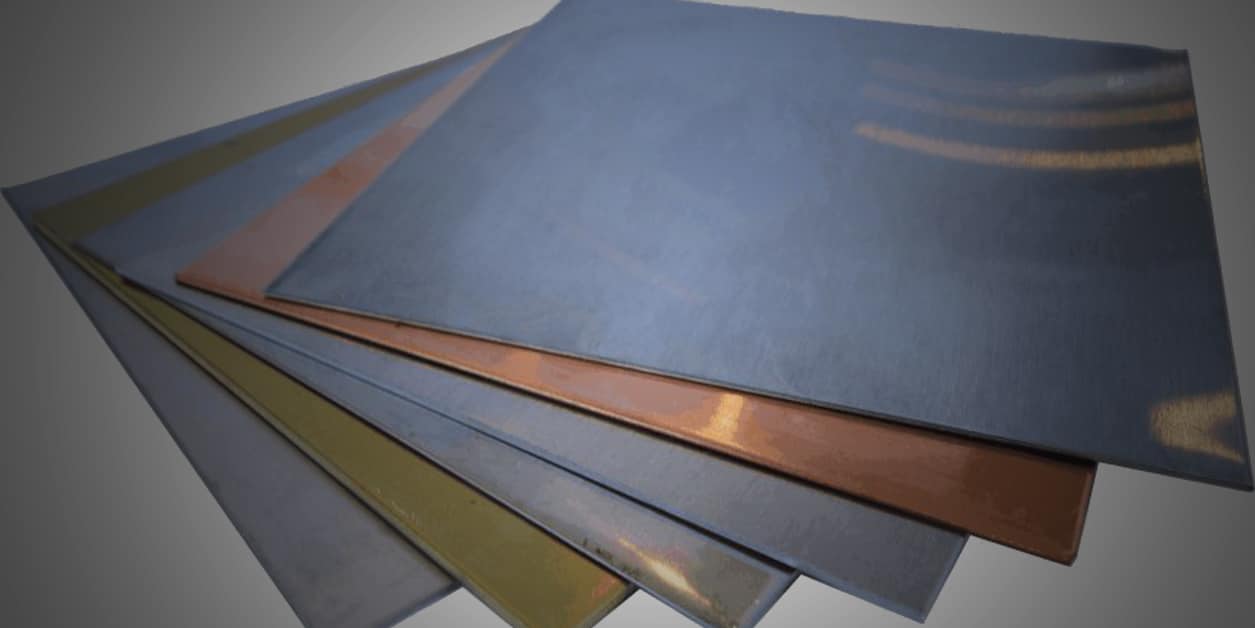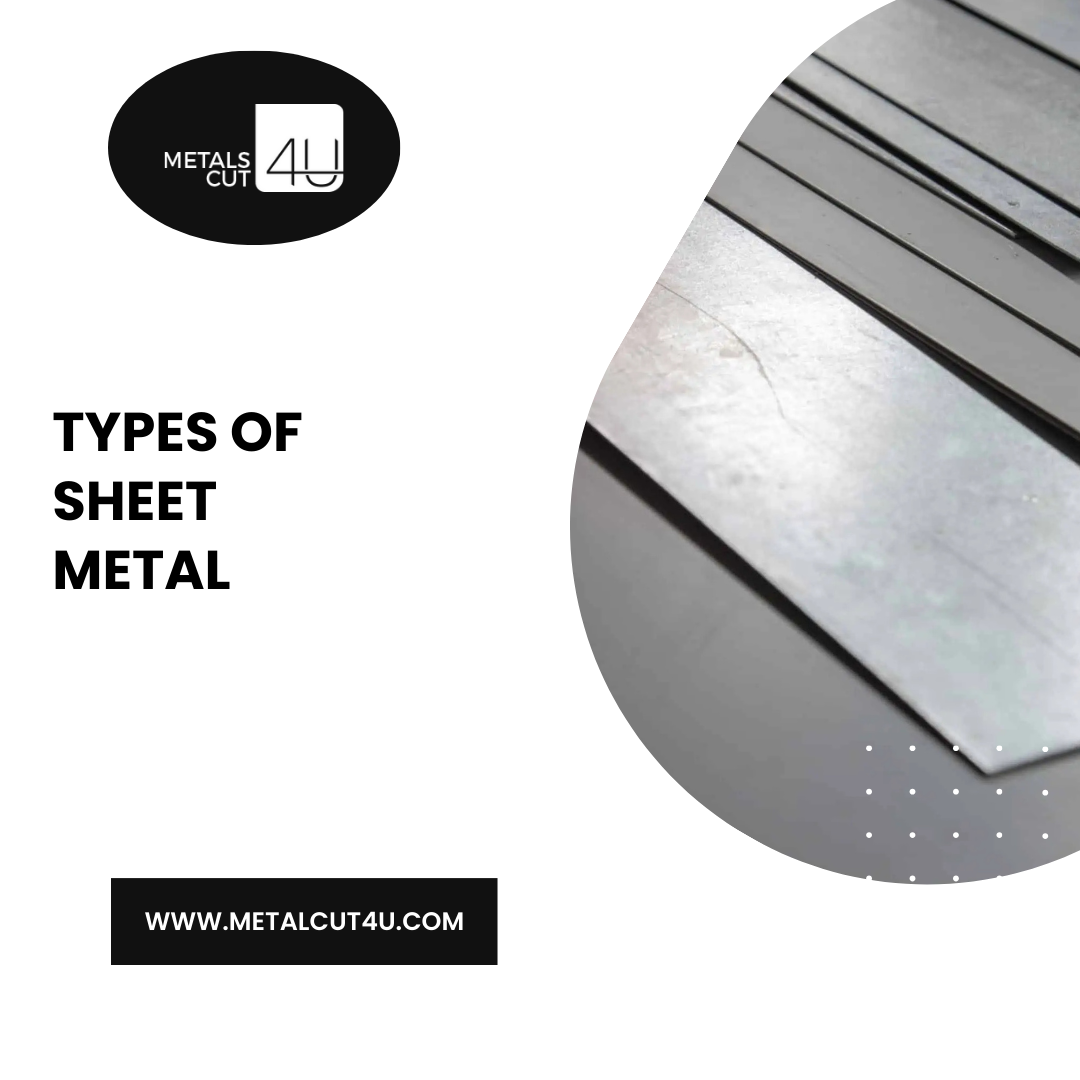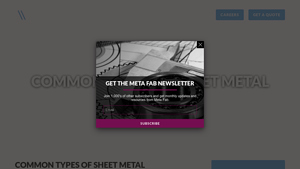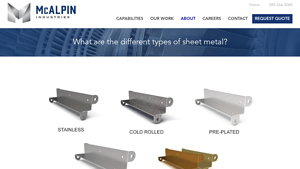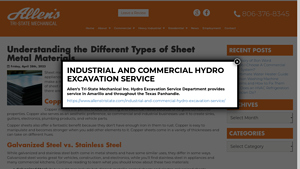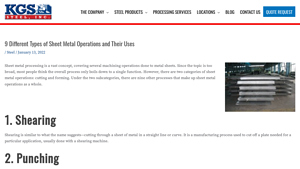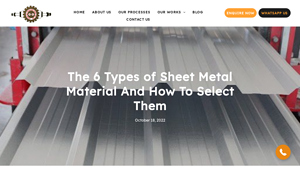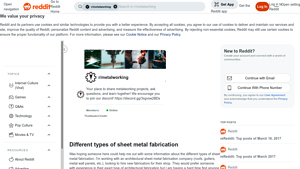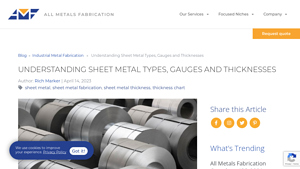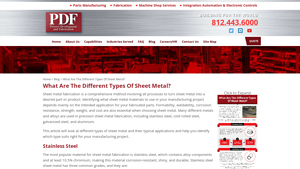Different Types Of Sheet Metal Guide: Type, Cost, Top List…
Introduction: Navigating the Global Market for different types of sheet metal
Navigating the complexities of sourcing different types of sheet metal can be a daunting challenge for B2B buyers, especially when considering factors such as material properties, applications, and regional availability. This comprehensive guide aims to demystify the global market for sheet metal by detailing various materials—including stainless steel, aluminum, galvanized steel, and more—alongside their respective strengths and ideal applications. Understanding these nuances is crucial for making informed purchasing decisions that align with specific project requirements and operational goals.
As international buyers from regions like Africa, South America, the Middle East, and Europe seek reliable suppliers, this guide will also cover essential aspects of supplier vetting, cost considerations, and market trends. Whether you’re in Nigeria looking for durable construction materials or in Brazil sourcing lightweight components for automotive manufacturing, our insights will empower you to navigate the intricacies of the sheet metal supply chain effectively. By equipping yourself with the right knowledge, you can ensure that your selections not only meet quality standards but also enhance your competitive edge in the marketplace.
In an ever-evolving global landscape, this guide serves as a valuable resource, helping you make strategic decisions that foster growth and innovation in your business endeavors.
Understanding different types of sheet metal Types and Variations
| Type Name | Key Distinguishing Features | Primary B2B Applications | Brief Pros & Cons for Buyers |
|---|---|---|---|
| Stainless Steel | High corrosion resistance, various grades (Austenitic, Ferritic) | Food processing, medical equipment, automotive | Pros: Durable, versatile; Cons: Higher cost |
| Aluminum | Lightweight, excellent corrosion resistance, good conductivity | Aerospace, automotive parts, electrical devices | Pros: Lightweight, recyclable; Cons: Less strong |
| Cold Rolled Steel | Smooth finish, tight tolerances, available in various alloys | Construction, automotive, appliances | Pros: High strength, good surface finish; Cons: Prone to rust without coating |
| Galvanized Steel | Zinc-coated for corrosion resistance, durable | Construction, automotive, HVAC systems | Pros: Cost-effective, long-lasting; Cons: Limited aesthetic appeal |
| Copper | High electrical and thermal conductivity, expensive | Electrical components, plumbing, roofing | Pros: Excellent conductivity; Cons: Higher cost |
What are the Characteristics of Stainless Steel in Sheet Metal Applications?
Stainless steel is renowned for its excellent corrosion resistance and durability, making it a preferred choice for various industries. It comes in multiple grades, with Austenitic (300 series) being the most common due to its non-magnetic properties and superior formability. Ferritic grades (400 series) are often used in decorative applications. When purchasing, buyers should consider the specific grade needed for their application, as this can impact both performance and cost.
How Does Aluminum Stand Out in Sheet Metal Fabrication?
Aluminum is favored for its lightweight nature and outstanding corrosion resistance, making it ideal for applications in the aerospace and automotive sectors. It is available in various grades, each offering unique characteristics such as good weldability and thermal conductivity. Buyers should evaluate the specific grade based on the required strength and application, balancing performance with cost-effectiveness.
What are the Advantages of Cold Rolled Steel?
Cold rolled steel is processed to provide a smooth finish and tighter tolerances compared to hot rolled steel. It is available in various alloys, allowing for high strength and excellent surface quality, making it suitable for precision applications in construction and automotive industries. Buyers should consider the potential for rust without protective coatings, as well as the specific requirements for strength and finish in their projects.
Why Choose Galvanized Steel for Corrosion Resistance?
Galvanized steel is coated with zinc to enhance its corrosion resistance, making it a cost-effective solution for various applications, including construction and automotive parts. Its durability makes it suitable for outdoor use. However, buyers should be aware of its aesthetic limitations and consider whether a galvanized finish meets their design needs.
What Makes Copper a Valuable Choice in Sheet Metal?
Copper is recognized for its superior electrical and thermal conductivity, making it an excellent choice for electrical components and plumbing applications. While it is more expensive than other metals, its performance in demanding environments justifies the cost for many businesses. Buyers should assess the trade-off between initial investment and long-term benefits in conductivity and durability for their specific applications.
Key Industrial Applications of different types of sheet metal
| Industry/Sector | Specific Application of different types of sheet metal | Value/Benefit for the Business | Key Sourcing Considerations for this Application |
|---|---|---|---|
| Automotive | Structural components and body panels made from aluminum and galvanized steel | Lightweight materials improve fuel efficiency and performance | Ensure compliance with regional safety standards and corrosion resistance requirements |
| Construction | Roofing and siding made from galvanized and aluminized steel | Enhanced durability and weather resistance reduce maintenance costs | Evaluate local climate conditions and ensure appropriate coatings for corrosion protection |
| Electronics | Heat sinks and enclosures fabricated from copper and aluminum | Improved thermal management extends product life and reliability | Assess conductivity needs and ensure compliance with international electrical safety standards |
| Food Processing | Cooking equipment and storage containers made from stainless steel | Corrosion resistance and hygiene support food safety standards | Verify grades of stainless steel for specific food contact regulations and ease of cleaning |
| HVAC | Ductwork and components made from galvanized steel and aluminum | Efficiency in airflow design reduces energy costs for systems | Consider insulation requirements and ensure compatibility with local energy efficiency codes |
How is Sheet Metal Utilized in the Automotive Industry?
In the automotive sector, aluminum and galvanized steel are crucial for producing structural components and body panels. The lightweight nature of aluminum enhances fuel efficiency, while galvanized steel provides corrosion resistance essential for vehicle longevity. Buyers in this industry must ensure that their materials meet regional safety standards and specifications to withstand harsh environments, particularly in regions with extreme weather conditions.
What Role Does Sheet Metal Play in Construction?
Galvanized and aluminized steel are commonly used in roofing and siding applications due to their durability and weather resistance. These materials help reduce maintenance costs by providing long-lasting protection against corrosion and environmental elements. Construction buyers must evaluate local climate conditions when sourcing materials and consider additional coatings or treatments to enhance durability in specific environments.
How is Sheet Metal Important in Electronics Manufacturing?
In electronics, copper and aluminum sheet metals are utilized for heat sinks and enclosures, where effective thermal management is vital. These materials ensure reliable performance and longevity of electronic devices by dissipating heat efficiently. B2B buyers need to assess the electrical conductivity requirements of their applications and ensure compliance with international safety standards, especially for products intended for global markets.
Why is Sheet Metal Essential in Food Processing?
Stainless steel is favored in the food processing industry for cooking equipment and storage containers due to its corrosion resistance and hygienic properties. This ensures compliance with food safety standards while facilitating ease of cleaning and maintenance. Buyers must verify the specific grades of stainless steel they source, ensuring they meet food contact regulations and are suitable for the types of food being processed.
What are the Key Applications of Sheet Metal in HVAC Systems?
In HVAC systems, galvanized steel and aluminum are commonly used for ductwork and various components. The efficiency of airflow design significantly impacts energy costs, making the choice of materials critical. Buyers in this sector should consider insulation requirements and ensure that sourced materials comply with local energy efficiency codes to optimize system performance and reduce operational costs.
3 Common User Pain Points for ‘different types of sheet metal’ & Their Solutions
Scenario 1: Challenges with Material Selection for Corrosion Resistance
The Problem:
B2B buyers often grapple with choosing the right sheet metal that offers adequate corrosion resistance, particularly in industries exposed to harsh environments, such as marine applications or chemical processing. Selecting a material that is both cost-effective and durable can be daunting, especially when facing a myriad of options like stainless steel, galvanized steel, and aluminum. A wrong choice could lead to premature material degradation, increased maintenance costs, and project delays.
The Solution:
To mitigate this challenge, buyers should conduct a comprehensive analysis of the environmental conditions their products will face. For instance, when working in a marine environment, opting for Grade 316 stainless steel, known for its superior corrosion resistance, is advisable. If cost is a significant concern, galvanized steel might be a viable alternative, offering decent protection at a lower price point. Buyers should engage with suppliers who can provide detailed material data sheets, including corrosion resistance ratings, and consider conducting small-scale tests of the selected materials under simulated environmental conditions. This proactive approach ensures that the right material is chosen, significantly reducing the risk of failure due to corrosion.
Scenario 2: Difficulty in Achieving Precise Fabrication Tolerances
The Problem:
In precision sheet metal fabrication, achieving tight tolerances is crucial for the final product’s performance and aesthetics. B2B buyers frequently encounter issues when the selected sheet metal does not maintain its integrity during processing, leading to warping or dimensional inaccuracies. This problem is particularly prevalent when using materials like aluminum or cold-rolled steel, which can behave unpredictably under stress or heat.
The Solution:
To ensure precise fabrication, buyers should prioritize sourcing high-quality materials from reputable suppliers that adhere to stringent manufacturing standards. It’s advisable to specify the desired tolerances in the procurement process and work closely with suppliers who can offer options such as cold-rolled steel that is processed to tighter tolerances or aluminum grades specifically designed for enhanced workability. Furthermore, investing in advanced fabrication technology, such as laser cutting and CNC machining, can also improve accuracy. Buyers should also engage in regular communication with their fabricators to ensure that the materials are handled correctly throughout the fabrication process, which helps maintain the integrity of the sheet metal and meet the necessary specifications.
Scenario 3: Managing Weight and Strength Trade-offs in Metal Selection
The Problem:
In industries like automotive and aerospace, B2B buyers often face the challenge of balancing weight and strength when selecting sheet metal. Using heavier materials can enhance durability but also increases overall weight, negatively impacting fuel efficiency and performance. Conversely, opting for lighter materials may compromise strength and safety, creating a dilemma for buyers striving for optimal performance without sacrificing quality.
The Solution:
To address this trade-off, buyers should consider advanced materials such as high-strength aluminum alloys or specialized steels that offer superior strength-to-weight ratios. For example, utilizing aluminum 6061, which provides excellent strength while remaining lightweight, can be advantageous in automotive applications. Additionally, buyers should collaborate with material scientists or engineers who can conduct simulations or modeling to evaluate different material combinations and their impact on overall product performance. This data-driven approach will enable buyers to make informed decisions that align with their performance goals while adhering to weight constraints. Furthermore, incorporating design strategies such as optimizing the geometry of parts can also help reduce weight without sacrificing strength.
Strategic Material Selection Guide for different types of sheet metal
What Are the Key Properties of Stainless Steel for Sheet Metal Applications?
Stainless steel is a versatile material widely used in sheet metal fabrication, particularly in industries requiring high corrosion resistance and durability. The most common grades include 304 and 316, which are known for their excellent formability and weldability. Grade 316 offers superior corrosion resistance, making it ideal for marine applications and environments with high chloride exposure. However, the higher nickel content in these grades can lead to increased costs.
Pros and Cons: The durability of stainless steel is a significant advantage, as it can withstand harsh environments without degrading. Its aesthetic appeal also makes it suitable for consumer-facing products. On the downside, the manufacturing complexity can be higher due to the need for specialized equipment for welding and forming. Additionally, the initial cost is typically higher than other metals.
Impact on Application: Stainless steel’s compatibility with various media, including chemicals and high temperatures, makes it suitable for food processing, pharmaceuticals, and marine applications.
Considerations for International Buyers: Buyers from regions like Africa and South America should consider the availability of specific grades and compliance with international standards such as ASTM and DIN. Understanding local regulations regarding corrosion resistance can also influence material selection.
How Does Aluminum Compare as a Sheet Metal Option?
Aluminum is another popular choice in sheet metal fabrication due to its excellent strength-to-weight ratio and natural corrosion resistance. Common grades include 1100 and 6061, with applications ranging from automotive parts to electrical devices. Aluminum is lightweight, making it easier to transport and handle during manufacturing processes.
Pros and Cons: The primary advantage of aluminum is its low density, which contributes to reduced shipping costs and improved energy efficiency in applications like transportation. However, it is generally less strong than stainless steel and may not be suitable for heavy-duty applications. Additionally, aluminum can be more expensive than carbon steel.
Impact on Application: Aluminum’s corrosion resistance makes it ideal for outdoor applications and environments prone to moisture. It is also non-toxic and recyclable, aligning with sustainability goals.
Considerations for International Buyers: For buyers in Europe and the Middle East, understanding the specific aluminum grades that comply with local standards is crucial. The availability of recycled aluminum may also be a factor in material selection.
What Are the Benefits of Using Galvanized Steel in Sheet Metal Fabrication?
Galvanized steel is carbon steel that has been coated with zinc to enhance its corrosion resistance. This material is commonly used in construction, automotive, and appliance manufacturing. The galvanization process provides a protective layer that can withstand environmental exposure.
Pros and Cons: The key advantage of galvanized steel is its cost-effectiveness and durability, making it a popular choice for budget-sensitive projects. However, the zinc coating can be prone to scratching, which may expose the underlying steel to corrosion if not properly maintained.
Impact on Application: Galvanized steel is particularly suitable for applications where moisture exposure is a concern, such as roofing and fencing. Its compatibility with various construction materials also enhances its versatility.
Considerations for International Buyers: Buyers in regions like Nigeria and Brazil should be aware of local standards for galvanized steel, including compliance with ASTM A123 for hot-dip galvanizing. Understanding the environmental conditions in which the material will be used is also essential for ensuring long-term performance.
How Does Copper and Brass Fit into the Sheet Metal Landscape?
Copper and brass are less common but valuable materials in sheet metal applications, particularly in electrical and architectural contexts. Copper offers excellent electrical and thermal conductivity, while brass, an alloy of copper and zinc, is known for its aesthetic appeal and machinability.
Pros and Cons: The primary advantage of copper is its superior conductivity, making it ideal for electrical components. Brass, on the other hand, is easier to machine and offers good corrosion resistance. However, both materials can be more expensive than traditional options like steel and aluminum, which may limit their use in large-scale applications.
Impact on Application: Copper is often used in electrical wiring and plumbing, while brass is favored for decorative elements and fittings. Both materials provide unique aesthetic qualities that can enhance product appeal.
Considerations for International Buyers: Buyers should consider the availability of these materials in their regions and any specific standards related to electrical applications. Understanding the cost implications of using copper and brass versus more common materials is also essential for budget planning.
| Material | Typical Use Case for different types of sheet metal | Key Advantage | Key Disadvantage/Limitation | Relative Cost (Low/Med/High) |
|---|---|---|---|---|
| Stainless Steel | Food processing, pharmaceuticals, marine applications | High corrosion resistance | Higher cost and manufacturing complexity | High |
| Aluminum | Automotive parts, electrical devices | Lightweight and corrosion-resistant | Less strong than stainless steel | Medium |
| Galvanized Steel | Roofing, fencing, automotive applications | Cost-effective and durable | Zinc coating can be scratched | Low |
| Copper/Brass | Electrical components, decorative fittings | Excellent conductivity and aesthetics | Higher cost compared to steel/aluminum | High |
In-depth Look: Manufacturing Processes and Quality Assurance for different types of sheet metal
What Are the Main Stages of Manufacturing Processes for Different Types of Sheet Metal?
The manufacturing of sheet metal involves several crucial stages that ensure the final product meets the specific requirements of various applications. These stages include material preparation, forming, assembly, and finishing. Each stage employs specific techniques tailored to the material properties of the sheet metal being processed.
How Is Material Prepared for Sheet Metal Fabrication?
Material preparation is the first stage in the manufacturing process. It involves selecting the appropriate type of metal, which can range from stainless steel to aluminum, based on the desired properties such as strength, corrosion resistance, and formability. The chosen metal is typically delivered in large rolls or sheets, which are then cut to size using shearing or laser cutting techniques.
For materials like aluminum, pre-treatment processes may include cleaning and anodizing to enhance corrosion resistance. For steel materials, processes like galvanization may be employed to apply a protective zinc coating, which is essential for products that will be exposed to moisture or corrosive environments.
What Forming Techniques Are Used in Sheet Metal Manufacturing?
Forming is the next critical stage in sheet metal fabrication, where the prepared metal is shaped into the desired form. Common forming techniques include:
- Bending: Utilizing press brakes, the metal is bent at specific angles to create various shapes.
- Stamping: This technique uses dies to cut or shape the metal into specific forms and is ideal for high-volume production.
- Deep Drawing: Suitable for creating deep, hollow shapes, this method stretches the metal into a mold, requiring careful control of material properties to prevent tearing.
- Laser Cutting: A precision method that uses a laser beam to cut intricate shapes and designs from the sheet metal.
Each of these methods has specific advantages and considerations, including tooling costs, production speed, and material waste.
How Does the Assembly Process Work for Sheet Metal Products?
In the assembly stage, various components created from sheet metal are joined together. Techniques such as welding, riveting, and adhesive bonding are commonly used, depending on the application requirements.
Welding is often preferred for its strength and durability, especially in heavy-duty applications. For lighter applications, riveting or adhesive bonding may be used for ease of assembly and to avoid the heat-affected zones associated with welding.
Proper assembly is critical to ensuring the structural integrity of the final product, particularly in industries such as automotive and aerospace where safety is paramount.
What Finishing Processes Are Commonly Applied to Sheet Metal?
Finishing processes enhance the aesthetic appeal and functional performance of sheet metal products. Common finishing techniques include:
- Painting: Provides an additional layer of protection against corrosion while offering a wide range of aesthetic options.
- Plating: Processes such as electroplating apply a thin layer of metal (like zinc or chrome) to improve corrosion resistance and enhance appearance.
- Powder Coating: A dry finishing process that provides a durable finish and is more environmentally friendly than traditional liquid paints.
These finishing techniques can significantly impact the longevity and performance of sheet metal products, making them essential considerations in the manufacturing process.
What Quality Control Standards Should Be Considered in Sheet Metal Manufacturing?
Quality control (QC) is vital to ensure that the final products meet the necessary standards for performance and safety. Adhering to international standards such as ISO 9001 and industry-specific certifications like CE or API is critical for B2B buyers, particularly in global markets.
Which International Standards Apply to Sheet Metal Quality Control?
ISO 9001 is a widely recognized standard that outlines quality management principles, including customer focus, process approach, and continual improvement. Compliance with ISO 9001 assures buyers that the manufacturer has a robust quality management system in place.
For specific industries, other standards may apply. For example, the CE mark is crucial for products sold in the European market, indicating compliance with health, safety, and environmental protection standards. Similarly, API specifications are essential for manufacturers in the oil and gas sector, ensuring products meet industry performance and safety criteria.
What Are the Key Quality Control Checkpoints in Sheet Metal Manufacturing?
Quality control in sheet metal manufacturing involves several checkpoints throughout the production process:
- Incoming Quality Control (IQC): This initial checkpoint assesses the quality of raw materials before they enter the production process. It ensures that only materials meeting specified standards are used.
- In-Process Quality Control (IPQC): Conducted during manufacturing, this involves monitoring the production process to detect defects early, allowing for immediate corrective actions.
- Final Quality Control (FQC): The final inspection before shipping, FQC ensures that the finished product meets all specifications and quality standards.
Common testing methods employed during these checkpoints include dimensional inspection, visual inspection, and non-destructive testing techniques like ultrasonic or X-ray inspections.
How Can B2B Buyers Verify Supplier Quality Control Processes?
For international B2B buyers, particularly those in regions like Africa, South America, the Middle East, and Europe, verifying a supplier’s quality control processes is essential to ensure product reliability. Here are some actionable steps buyers can take:
- Conduct Supplier Audits: Regularly auditing suppliers helps assess their compliance with quality standards and manufacturing processes. This can include checking their ISO certifications and quality management systems.
- Request Quality Control Reports: Suppliers should provide documentation detailing their QC processes, including inspection reports and compliance with relevant standards.
- Utilize Third-Party Inspection Services: Engaging third-party inspection agencies can provide an unbiased assessment of the supplier’s quality control measures. This is particularly useful for high-stakes projects where product failure can have significant consequences.
What Are the Quality Control and Certification Nuances for International B2B Buyers?
Navigating the quality control landscape in international markets can be complex. B2B buyers should be aware of the following nuances:
- Regional Standards: Different regions may have specific quality standards that must be met. For example, products sold in Europe must often comply with CE marking, while products in the U.S. might require adherence to ASTM standards.
- Cultural Considerations: Understanding cultural differences in business practices can affect quality expectations. For instance, some regions may place a higher emphasis on documentation and certification, while others might focus more on relationship-based assurances.
- Communication: Clear communication regarding quality expectations and standards is crucial. Buyers should ensure that suppliers understand their requirements and are capable of meeting them consistently.
By adopting these practices, B2B buyers can enhance their confidence in sourcing sheet metal products that meet their quality and performance needs, ultimately leading to successful partnerships and projects.
Practical Sourcing Guide: A Step-by-Step Checklist for ‘different types of sheet metal’
Introduction
Sourcing the right type of sheet metal is a critical aspect for businesses involved in manufacturing and fabrication. This guide serves as a practical checklist for international B2B buyers, helping you navigate the complexities of selecting the appropriate materials while considering various factors such as application needs, supplier reliability, and cost-effectiveness.
Step 1: Define Your Technical Specifications
Establishing clear technical specifications is the first step in sourcing sheet metal. Consider factors such as thickness, material type, strength, and corrosion resistance based on the intended application. This clarity will guide your selection process and help communicate your needs effectively to suppliers.
- Material Requirements: Specify whether you need stainless steel, aluminum, galvanized steel, or another type based on your project’s demands.
- Performance Standards: Identify any industry standards or certifications the sheet metal must meet.
Step 2: Research Available Materials
Understanding the characteristics of various sheet metal types is essential for making informed decisions. Research the different metals and alloys, focusing on their properties like formability, weldability, and weight.
- Common Materials: Familiarize yourself with commonly used materials such as stainless steel grades (304, 316), aluminum alloys (5052, 6061), and carbon steel.
- Application Suitability: Match the material properties with your application requirements to ensure optimal performance.
Step 3: Evaluate Potential Suppliers
Before committing to a supplier, thorough evaluation is crucial. Assess suppliers based on their experience, reliability, and reputation in the industry.
- Company Profiles: Request detailed profiles that highlight their capabilities, past projects, and customer reviews.
- Certifications: Verify any industry-specific certifications or quality assurances they possess.
Step 4: Request Samples for Testing
Once you have narrowed down potential suppliers, request samples of the sheet metal you intend to purchase. Testing samples will help you evaluate the quality and suitability for your application.
- Quality Assessment: Check for defects, consistency, and adherence to your specifications.
- Performance Testing: Conduct necessary tests to ensure the material meets your technical requirements.
Step 5: Compare Pricing and Terms
Gather quotes from multiple suppliers to compare pricing and payment terms. Consider not only the cost per unit but also any additional fees, shipping costs, and lead times.
- Total Cost of Ownership: Evaluate the overall cost, including potential savings on bulk orders or long-term contracts.
- Negotiation Opportunities: Don’t hesitate to negotiate terms that align with your budget and requirements.
Step 6: Verify Supplier Logistics and Delivery Times
Understanding the supplier’s logistics capabilities and delivery timelines is vital to ensure timely project execution. Confirm their shipping methods and estimated delivery dates.
- Reliability: Choose suppliers with proven track records of timely deliveries to avoid project delays.
- Geographical Considerations: Consider the supplier’s location relative to your operations to minimize shipping costs and time.
Step 7: Establish a Communication Plan
Effective communication with your chosen supplier is key to a successful partnership. Set up a communication plan that outlines how you will manage updates, inquiries, and any issues that arise during the sourcing process.
- Regular Updates: Schedule regular check-ins to discuss progress and address any concerns.
- Point of Contact: Designate a specific contact person for streamlined communication.
By following this checklist, B2B buyers can make informed decisions when sourcing sheet metal, ensuring that they select the right materials for their projects while fostering reliable supplier relationships.
Comprehensive Cost and Pricing Analysis for different types of sheet metal Sourcing
What Are the Key Cost Components in Sheet Metal Sourcing?
When evaluating the cost structure for different types of sheet metal, several components come into play:
-
Materials: The choice of metal significantly impacts the cost. For instance, stainless steel and aluminum typically command higher prices due to their favorable properties like corrosion resistance and strength-to-weight ratio. In contrast, cold-rolled steel and galvanized steel may be more cost-effective for certain applications.
-
Labor: The complexity of the fabrication process determines labor costs. Custom designs or intricate specifications require skilled labor, which can elevate prices. Conversely, standard products might incur lower labor costs due to streamlined processes.
-
Manufacturing Overhead: This includes costs associated with equipment maintenance, facility expenses, and utilities. High-tech processes like laser cutting may have a higher overhead due to the machinery involved, while simpler methods could reduce these costs.
-
Tooling: For custom projects, tooling costs can be substantial. The need for specialized dies or molds adds to initial expenses, particularly in low-volume orders. Therefore, tooling is a critical factor to consider in the overall pricing strategy.
-
Quality Control (QC): Ensuring product quality through rigorous QC processes adds to the cost. Certifications such as ISO or ASTM compliance can also influence pricing, especially for industries with strict regulatory requirements.
-
Logistics: Shipping costs vary based on weight, dimensions, and distance. International buyers should also consider duties and tariffs, which can significantly affect the total cost.
-
Margin: Suppliers typically add a profit margin to their costs, which can vary widely based on market conditions and competition.
What Factors Influence the Pricing of Sheet Metal?
Several factors impact the pricing structure for sheet metal, particularly for international B2B buyers:
-
Volume and Minimum Order Quantity (MOQ): Larger orders often qualify for volume discounts. However, lower MOQs may incur higher per-unit costs. Buyers should balance their needs with cost implications.
-
Specifications and Customization: Custom specifications can raise prices due to additional labor, tooling, and material costs. Buyers should weigh the benefits of custom solutions against their budget.
-
Material Selection: The type of metal chosen directly influences pricing. For example, high-grade stainless steel will typically be more expensive than carbon steel.
-
Quality and Certifications: Products that meet specific quality standards or certifications tend to be priced higher. Buyers should assess whether these certifications are necessary for their applications.
-
Supplier Factors: Supplier reliability, reputation, and location can influence pricing. Suppliers with extensive experience and a strong track record may charge a premium, but they often provide better service and quality assurance.
-
Incoterms: Understanding the terms of shipping and delivery (e.g., FOB, CIF) is critical. These terms dictate who bears the costs and risks at various points in the shipping process, impacting the overall price.
What Are the Best Negotiation Tips for International B2B Buyers?
International buyers, particularly from regions like Africa, South America, and the Middle East, should consider the following tips:
-
Leverage Volume: Use bulk purchasing power to negotiate better pricing. Suppliers are often more willing to lower costs for larger orders.
-
Evaluate Total Cost of Ownership (TCO): Consider not just the initial purchase price but also the long-term costs associated with quality, maintenance, and logistics. A higher upfront cost may be justified by lower operational costs over time.
-
Research Market Prices: Understanding the current market rates for different types of sheet metal helps buyers negotiate more effectively.
-
Build Relationships: Establishing a good rapport with suppliers can lead to better terms and prices. Suppliers may be more willing to accommodate loyal clients.
-
Request Samples: Before committing to a large order, ask for samples to assess quality. This can prevent costly mistakes and ensure that the material meets specifications.
What Should International Buyers Keep in Mind Regarding Pricing Nuances?
International B2B buyers must navigate various pricing nuances:
-
Currency Fluctuations: Be aware of exchange rates and their potential impact on pricing.
-
Import Duties and Taxes: Factor in additional costs associated with importing materials, which can vary by country.
-
Shipping Times: Longer shipping times may necessitate higher costs for expedited services.
-
Cultural Factors: Understanding local business practices and negotiation styles can enhance communication and lead to favorable outcomes.
Disclaimer on Pricing
Prices for sheet metal can fluctuate based on market conditions, supplier availability, and other external factors. It is advisable for buyers to obtain current quotes and conduct thorough market research before making procurement decisions.
Alternatives Analysis: Comparing different types of sheet metal With Other Solutions
In the world of manufacturing and construction, selecting the right materials is critical for ensuring durability, performance, and cost-effectiveness. Sheet metal, available in various types and alloys, is a popular choice for many applications. However, there are alternative materials and methods that may also serve similar functions. This analysis will compare different types of sheet metal against viable alternatives, helping B2B buyers make informed decisions.
| Comparison Aspect | Different Types of Sheet Metal | Aluminized Steel | Composite Materials |
|---|---|---|---|
| Performance | High strength-to-weight ratio; excellent formability and corrosion resistance depending on the type | Combines the strength of steel with corrosion resistance of aluminum; suitable for high-temperature applications | Lightweight, strong, and resistant to corrosion and chemicals; offers design flexibility |
| Cost | Moderate to high depending on the alloy; stainless steel tends to be pricier | Generally lower than stainless steel but higher than basic carbon steel | Can be high due to manufacturing processes but often offset by lower operational costs |
| Ease of Implementation | Requires specialized tools for cutting and forming; welding is common | Similar processing to steel; can be welded and formed easily | Requires specific fabrication techniques; may need specialized adhesives or fasteners |
| Maintenance | Requires regular maintenance depending on corrosion resistance; stainless steel is low maintenance | Low maintenance due to corrosion resistance | Maintenance varies; some composites may need periodic checks for delamination |
| Best Use Case | Ideal for structural components, automotive parts, and appliances | Best for applications in kitchens, automotive exhausts, and any environment prone to corrosion | Suitable for aerospace, automotive, and high-performance applications requiring weight savings |
What Are the Pros and Cons of Aluminized Steel?
Aluminized steel is a unique combination of carbon steel coated with an aluminum-silicon alloy. This material offers significant advantages, such as enhanced corrosion resistance and the ability to withstand high temperatures. Its cost-effectiveness makes it a popular choice for applications like automotive parts and kitchen appliances. However, it is not as strong as stainless steel and may require additional protective measures in extremely corrosive environments.
How Do Composite Materials Compare?
Composite materials, which combine two or more distinct materials to achieve superior properties, are increasingly used in various industries. They are lightweight and resistant to corrosion, making them ideal for aerospace and automotive applications. However, the manufacturing processes can be more complex and costly compared to traditional sheet metal. Additionally, some composites may require specialized handling and installation techniques, which can add to overall project costs.
Conclusion: How Can B2B Buyers Make the Right Choice?
When choosing between different types of sheet metal and alternatives like aluminized steel or composite materials, B2B buyers should consider several factors, including application requirements, budget constraints, and long-term maintenance needs. Each material has unique benefits and limitations that may align better with specific project goals. Conducting a thorough analysis of the material properties, cost implications, and intended use cases will empower buyers to select the most appropriate solution for their manufacturing or construction needs.
Essential Technical Properties and Trade Terminology for different types of sheet metal
What Are the Key Technical Properties of Different Types of Sheet Metal?
Understanding the essential technical properties of sheet metal is crucial for B2B buyers, as these specifications directly impact the suitability of the material for specific applications. Here are some critical properties to consider:
-
Material Grade
Material grade refers to the classification of metals based on their chemical composition and mechanical properties. For example, stainless steel comes in various grades such as 304 and 316, each offering different levels of corrosion resistance and strength. Selecting the appropriate grade is vital for ensuring that the material meets the demands of the intended application, especially in sectors like automotive and construction. -
Thickness (Gauge)
The thickness of sheet metal is typically measured in gauges, with a lower gauge number indicating a thicker sheet. For instance, a 16-gauge sheet is thicker than an 18-gauge sheet. The thickness affects not only the weight and strength of the material but also its formability and weldability. Buyers must consider the thickness that aligns with their fabrication processes and end-use requirements. -
Tolerance
Tolerance refers to the permissible variation in dimensions and properties of the sheet metal. Tight tolerances are essential for applications requiring high precision, such as electronic components or aerospace parts. Understanding the tolerance specifications helps buyers ensure that the sheet metal will fit correctly in assemblies, reducing waste and rework costs. -
Corrosion Resistance
Corrosion resistance is a critical property for metals exposed to harsh environments, such as marine or industrial applications. Materials like galvanized steel or specific stainless steel grades are designed to resist rust and degradation. Buyers should assess the environmental conditions their products will face to select materials with adequate corrosion resistance. -
Formability
Formability indicates how easily a material can be shaped or deformed without cracking. This property is particularly important in industries like automotive and construction, where complex shapes are often required. Understanding the formability of different metals allows buyers to choose materials that can be efficiently processed into the desired shapes. -
Weight
The weight of sheet metal affects transportation and installation costs. Lighter materials, such as aluminum, are often preferred in applications where weight savings are critical, such as in aerospace or automotive industries. Buyers need to balance weight with strength and durability to ensure optimal performance.
What Are Common Trade Terms Related to Sheet Metal?
Familiarizing yourself with industry jargon can facilitate smoother communications and negotiations. Here are some common trade terms that B2B buyers should know:
-
OEM (Original Equipment Manufacturer)
An OEM refers to a company that produces parts or equipment that may be marketed by another manufacturer. Understanding OEM relationships can help buyers navigate sourcing strategies and ensure compatibility between components. -
MOQ (Minimum Order Quantity)
MOQ is the smallest quantity of a product that a supplier is willing to sell. Knowing the MOQ helps buyers plan their purchasing strategy and manage inventory effectively, especially when sourcing specialized sheet metal products. -
RFQ (Request for Quotation)
An RFQ is a document sent by a buyer to suppliers requesting pricing and terms for specific products or services. Issuing an RFQ is a common practice that helps buyers gather competitive bids and make informed purchasing decisions. -
Incoterms (International Commercial Terms)
Incoterms are a set of predefined international trade terms that clarify the responsibilities of buyers and sellers regarding shipping, insurance, and tariffs. Familiarity with Incoterms can help buyers negotiate better shipping terms and understand their obligations in international transactions. -
Lead Time
Lead time refers to the amount of time it takes from placing an order to receiving the goods. Understanding lead times is crucial for project planning and inventory management, particularly in industries where timely delivery is critical. -
Fabrication
Fabrication refers to the process of cutting, shaping, and assembling metal components to create a final product. Knowledge of fabrication techniques can help buyers communicate their requirements effectively and ensure that the sheet metal selected can be processed according to their specifications.
By understanding these technical properties and trade terms, B2B buyers can make informed decisions when sourcing sheet metal, ensuring that they select the right materials for their specific applications.
Navigating Market Dynamics and Sourcing Trends in the different types of sheet metal Sector
What Are the Current Market Dynamics and Key Trends in the Sheet Metal Sector?
The global sheet metal market is witnessing significant evolution driven by multiple factors. Increasing demand across various industries such as automotive, aerospace, construction, and electronics is propelling growth. For international B2B buyers, especially in Africa, South America, the Middle East, and Europe, the need for high-quality, cost-effective materials is paramount. Emerging technologies, such as advanced robotics in manufacturing and laser cutting, are enhancing precision and efficiency in sheet metal fabrication. Additionally, the trend toward customization is gaining traction, as businesses seek tailored solutions to meet specific application requirements.
Another key trend is the shift towards digital sourcing platforms, which streamline procurement processes. B2B buyers are increasingly leveraging online marketplaces to access a wider range of suppliers and materials, ensuring competitive pricing and improved supply chain management. Furthermore, sustainability is becoming a critical consideration, with buyers prioritizing materials that reduce environmental impact. This focus on sustainability is influencing sourcing decisions, prompting buyers to seek suppliers who can provide eco-friendly options.
How Are Sustainability and Ethical Sourcing Impacting the Sheet Metal Sector?
The emphasis on sustainability in the sheet metal sector is reshaping procurement strategies for B2B buyers. Environmental concerns surrounding mining, manufacturing, and disposal processes have led to a demand for materials that are recyclable and produced with minimal ecological impact. For instance, aluminum is favored for its high recyclability and lower energy consumption during production compared to other metals.
Ethical sourcing is also gaining importance. Buyers are increasingly scrutinizing their supply chains to ensure compliance with labor standards and environmental regulations. Certifications such as ISO 14001 for environmental management and LEED for sustainable building practices are becoming crucial in supplier selection. By choosing certified materials and suppliers, businesses not only enhance their brand reputation but also align with global sustainability goals.
In regions like Africa and South America, where resource management can be challenging, prioritizing ethical sourcing practices is vital. This approach fosters stronger relationships with local communities and can lead to a more resilient supply chain.
What Is the Historical Context of the Sheet Metal Industry Relevant to B2B Buyers?
The sheet metal industry has evolved significantly over the past century, adapting to advancements in technology and shifts in market demands. Initially dominated by traditional fabrication methods, the industry has embraced modern techniques such as computer numerical control (CNC) machining and automated welding. This evolution has not only improved precision but has also increased the speed of production, allowing manufacturers to respond swiftly to market needs.
Historically, steel and aluminum have been the primary materials used in sheet metal applications. However, the introduction of diverse alloys and coatings has expanded the range of applications, from automotive components to intricate electronic housings. For B2B buyers, understanding this historical context is essential, as it highlights the potential for innovation and the importance of selecting the right materials for specific applications.
In conclusion, as international B2B buyers navigate the complexities of the sheet metal market, staying informed about current trends, sustainability practices, and historical developments will empower them to make strategic sourcing decisions that align with their business goals.
Frequently Asked Questions (FAQs) for B2B Buyers of different types of sheet metal
-
How do I choose the right type of sheet metal for my project?
Selecting the appropriate sheet metal depends on several factors, including the intended application, environmental conditions, and required mechanical properties. Consider the metal’s formability, weldability, corrosion resistance, strength, weight, and cost. For example, stainless steel is ideal for applications requiring high corrosion resistance, while aluminum offers a great strength-to-weight ratio. Engage with suppliers who can provide technical guidance based on your specific needs and project requirements to ensure optimal material selection. -
What is the best metal for high-temperature applications?
For high-temperature applications, stainless steel grades such as 316 are recommended due to their excellent strength retention and corrosion resistance at elevated temperatures. Aluminized steel is another viable option, as it combines the strength of carbon steel with aluminum’s superior resistance to heat and corrosion. When sourcing these materials, ensure your supplier can provide certifications and mechanical property data to confirm their suitability for your specific application. -
What factors should I consider when vetting international sheet metal suppliers?
When vetting international suppliers, assess their manufacturing capabilities, quality control processes, and compliance with international standards. Check for certifications such as ISO 9001, which indicates a commitment to quality management. Additionally, inquire about their experience in your specific industry, customer references, and their ability to meet your specifications, including lead times and delivery schedules. A reliable supplier should also be responsive to communication and transparent about pricing and terms. -
What are the typical minimum order quantities (MOQs) for sheet metal?
Minimum order quantities for sheet metal can vary significantly based on the supplier and the type of material. Generally, MOQs may range from 100 to 1,000 kg for standard materials, but custom orders or specialized alloys might have higher MOQs. It’s essential to discuss your project requirements with potential suppliers to negotiate terms that fit your needs, especially if you require smaller quantities for prototypes or initial runs. -
What payment terms are commonly used in international sheet metal transactions?
Payment terms can vary widely among suppliers, but common practices include advance payments, letters of credit, and net payment terms (e.g., net 30 or net 60 days). It’s crucial to establish clear payment terms before finalizing any agreements to avoid misunderstandings. Ensure that you understand any currency exchange risks involved and consider using escrow services for larger transactions to protect both parties. -
How do I ensure quality assurance in my sheet metal orders?
Quality assurance starts with selecting reputable suppliers who have robust quality control processes. Request documentation such as material certifications, inspection reports, and compliance with industry standards. Conducting regular audits of the supplier’s facilities can also help ensure that they meet your quality expectations. If possible, consider using third-party inspection services to verify the quality of the materials before shipment. -
What are the logistics considerations for importing sheet metal?
When importing sheet metal, consider factors such as shipping costs, customs duties, and delivery timelines. Ensure that your supplier can provide accurate shipping information and documentation, including bills of lading and customs declarations. Familiarize yourself with the import regulations of your country to avoid delays or penalties. Partnering with a logistics provider experienced in international trade can help streamline the process and mitigate risks. -
Can I customize sheet metal products to meet my specific needs?
Yes, many suppliers offer customization options for sheet metal products, including specific dimensions, thicknesses, and finishes. Discuss your requirements with potential suppliers to determine their capabilities and any associated costs. Customization may also involve specialized fabrication processes, so ensure that the supplier has the necessary equipment and expertise. Always request samples or prototypes to validate that the final product meets your specifications before proceeding with larger orders.
Important Disclaimer & Terms of Use
⚠️ Important Disclaimer
The information provided in this guide, including content regarding manufacturers, technical specifications, and market analysis, is for informational and educational purposes only. It does not constitute professional procurement advice, financial advice, or legal advice.
While we have made every effort to ensure the accuracy and timeliness of the information, we are not responsible for any errors, omissions, or outdated information. Market conditions, company details, and technical standards are subject to change.
B2B buyers must conduct their own independent and thorough due diligence before making any purchasing decisions. This includes contacting suppliers directly, verifying certifications, requesting samples, and seeking professional consultation. The risk of relying on any information in this guide is borne solely by the reader.
Top 8 Different Types Of Sheet Metal Manufacturers & Suppliers List
1. Metafab – Sheet Metal Solutions
Domain: metafab.com
Registered: 1998 (27 years)
Introduction: Common types of sheet metal include:
1. Stainless Steel:
– Austenitic: Non-magnetic, high chromium and nickel, low carbon, known for formability and corrosion resistance.
– Ferritic: Magnetic, non-heat-treatable, 11-30% chromium, low nickel, used for non-structural and decorative applications.
– Martensitic: Chromium steels, no nickel, corrosion resistant, heat-treatable for various h…
2. Mcalpin Industries – Stainless Steel Sheets
Domain: mcalpin-ind.com
Registered: 1998 (27 years)
Introduction: Varied metals and metal alloys can be formed into sheets for fabrication. Key materials include:
1. Stainless Steel:
– Standard Stainless (non-magnetic, 300 series):
– Grade 316: Most corrosion-resistant, maintains strength at high temperatures.
– Grade 304: Widely used, good formability and weldability.
– Magnetic Stainless (400 series):
– Grade 410: Less corrosion resi…
3. Allen’s Tri-State – Sheet Metal Materials
Domain: allenstristate.com
Registered: 1999 (26 years)
Introduction: Types of Sheet Metal Materials: 1. Copper: Good conductive properties, used for wiring, sinks, gutters, plumbing products, and vehicle parts. Rust-resistant, easy to manipulate, available in various thicknesses. 2. Galvanized Steel: Subtypes include hot-dipped and electro-galvanized sheets. Used in vehicles, construction, and electronics. Easier to manipulate than stainless steel. 3. Stainless Ste…
4. KGS Steel – Metal Fabrication Services
Domain: kgssteel.com
Registered: 2002 (23 years)
Introduction: 1. Shearing: Cutting through a sheet of metal in a straight line or curve using a shearing machine. 2. Punching: Cutting holes in metal, typically circular or square, often used to apply edges or borders. 3. Perforating: Creating holes in metal using a press hammer, similar to punching. 4. Notching: Cutting a rectangular piece out of the edge of a metal sheet, often done with a notching or shearin…
5. Choong Ngan Engineering – Sheet Metal Materials
Domain: choongngaiengineering.com
Registered: 2022 (3 years)
Introduction: The text discusses six types of sheet metal materials: Alloy Steel, Stainless Steel, Carbon Steel, Tool Steel, and Galvanised Steel.
1. **Alloy Steel**:
– **Composition**: Primarily carbon steel with elements like tungsten, chromium, manganese, vanadium, and nickel.
– **Advantages**: Higher corrosion resistance, increased durability, hardness, and strength.
– **Disadvantages**: Low mac…
6. Reddit – Architectural Sheet Metal Fabrication
Domain: reddit.com
Registered: 2005 (20 years)
Introduction: Different types of sheet metal fabrication include HVAC, architectural, cabinet, ornamental, and machine parts. The focus is on architectural sheet metal fabrication, which involves roofs, gutters, and metal wall panels. The discussion highlights the difficulty in finding fabricators with specific architectural experience, as many have backgrounds in other types of fabrication. It suggests that sk…
7. All Metals Fabrication – Sheet Metal Types & Sizes
Domain: allmetalsfab.com
Registered: 1998 (27 years)
Introduction: Sheet metal types: aluminum, brass, copper, steel, titanium, tin, stainless steel; Common sheet sizes: 4′ x 10′, 5′ x 10′; Thickness range: 26 gauge (thinner) to 7 gauge (thicker); Gauge measurement: higher number = thinner sheet; Gauge tool measures thickness in thousandths of an inch; Aluminum classified by inches, not gauge; Thickness tolerance affects fabrication; Sheet metal fabrication focus…
8. PDF Inc – Sheet Metal Types
Domain: pdf-inc.com
Registered: 1998 (27 years)
Introduction: Sheet metal is categorized into various types based on the material used and the manufacturing process. The main types include:
1. **Aluminum Sheet Metal**: Lightweight, corrosion-resistant, and easy to work with.
2. **Steel Sheet Metal**: Strong and durable, available in various grades including stainless steel and carbon steel.
3. **Copper Sheet Metal**: Excellent conductivity and malleability, …
Strategic Sourcing Conclusion and Outlook for different types of sheet metal
As the global marketplace continues to evolve, the strategic sourcing of sheet metal plays a pivotal role in enhancing operational efficiency and product quality. Buyers should prioritize understanding the unique properties of various metals—including stainless steel, aluminum, and galvanized steel—to align material selection with specific application requirements. Factors such as formability, corrosion resistance, and cost-effectiveness must guide sourcing decisions to ensure optimal performance in diverse environments, from the demanding conditions of the Middle East to the burgeoning manufacturing sectors in Africa and South America.
Investing in strategic sourcing not only reduces material costs but also fosters sustainable practices through the use of recyclable materials like aluminum. By establishing strong relationships with reliable suppliers, international buyers can secure high-quality materials that meet stringent industry standards.
Looking ahead, the demand for innovative sheet metal solutions will only increase as industries adapt to new technologies and market needs. We encourage buyers to engage proactively with suppliers and industry experts to stay ahead of trends and ensure their sourcing strategies are both forward-thinking and resilient. Explore your options today to leverage the full potential of sheet metal in your projects and drive your business success.
